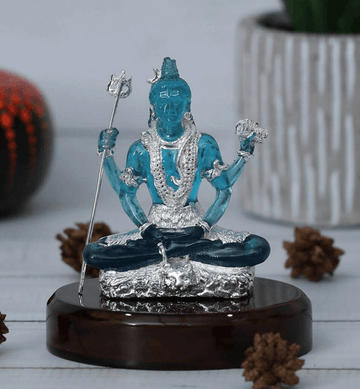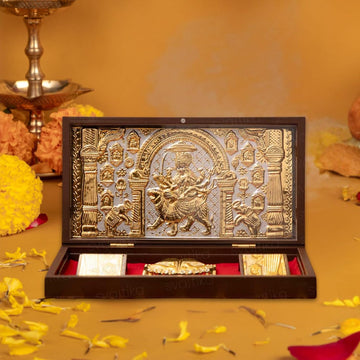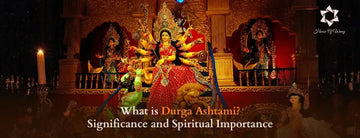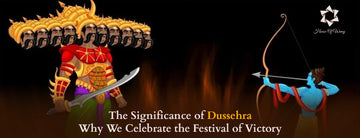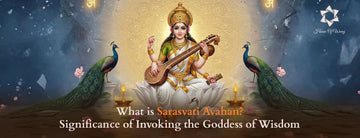Durga Ashtami: Meaning, Significance, and Spiritual Importance
In every household in India, celebrations are done with spirituality and happiness. The aroma of incense sticks, the ringing of bells, and people coming together in pandals that have been in their families for generations. This is the most discernible and spiritually powerful festival that is observed in the Navratri.
For most of us, Ashtami reminds us of childhood days when mothers used to prepare special dishes, fathers prepared puja materials, and elders used to ask us to clean our faces and bend in front of the Goddess Durga Idols. Even when we did not understand every aspect of Ashtami on that day, we all had something divine in the atmosphere. That is the magic of this day.
Meaning and Origin of Durga Ashtami
"Ashtami" normally connotes the eighth day of the lunar calendar. It is considered that the level of power related to goddess Durga peaks when the eighth day of the lunar calendar arrives in Navratri.
The Durga Ashtami significance in the Hindu religion belief is that the power of the Devi (the divine feminine energy or Shakti) bestows strength and protection upon the world on this day.
Ancient scriptures also state that Ashtami day worship has that extra diligence, since whatever is prayed for, in a clean heart, is attained very soon by the patterns of Devi worshipped here on this day. It is due to this subtlety of the worship of cleanliness on this day that generations have resonated with Durga Ashtami.
As all of us had experienced, elders often say to us, “Ashtami ke din devi ghar aati hain”, meaning:
This day is pure, lit, and filled with devotion, just as ‘our’ Devi comes or is believed to come.
Mythological Story Behind Durga Ashtami
Every festival has a story, and the story of Ashtami is all about bravery and hope. In the Hindu mythology stories of the demon Mahishasura, who was granted such strong abilities that he became invincible. Neither gods nor men could kill him. In their helplessness, the gods combined their energies, and from that union appeared the radiant and fierce goddess Durga.
- She held weapons given by each god.
- She rode a lion, symbolizing unstoppable courage.
- She fought for a long time, nine days to be exact, and very hard.
Her power peaked on the eighth day, Navratri Durga Ashtami, when she defeated the army of the demon. That is why Maha Ashtami is remembered as the time when the good truly overruled evil. As kids, we all have once heard a story from our dadi. The story of how Devi’s voice was heard across the heavens. That is what makes us believe in the victory of good over evil
Why is Durga Ashtami Observed in the Hindu Tradition?
The Durga Ashtami celebrations are more than rituals, but also invoke truth: evil may seem to be powerful, but truth is always conquering. For believers, this day is a time to usher in positivity and discard inner vulnerabilities such as rage, greed, or ego.
Individuals follow this day to:
- Seek protection from negative energies.
- Revere the feminine divine power.
- Cleanse the mind and body through fasting and devotion.
As our dadi or nani used to say, "Ashtami ke din jo bhi prarthna karo, devi maa use sun leti hain."
Rituals and Customs Done on Durga Ashtami
Durga Ashtami rituals across India unite families and communities. While the customs of each place may vary, some of the practices are universal:
- Putting up a Durga Ashtami puja altar through kalash sthapana.
- Offering sindoor, red flowers, and incense to the goddess Durga idols.
- Chanting mantras, hymns, and slokas from Durga Saptashati.
- Fasting is done in the observance of Durga Ashtami.
- Kanya puja, where young girls are revered as manifestations of Devi.
You may have also noticed the way kids look forward to taking prasad after puja, halwa, poori, and chana, filling the day with greater joy.
Meaning of Goddess Durga being Worshiped on the Eighth Day
The eighth day of Navratri is considered to be the most energetic. The devotees believe that a worship on this day is performed to eliminate obstacles, safeguard families, and infuse life with courage.
- It purifies the house from negativity.
- It gives inner peace and vigor.
- It fortifies faith in spiritual values.
Most devotees claim that the peacefulness they achieve following Durga Ashtami puja is not found on any other day. Perhaps you have felt the same feeling of lightness after attending a temple celebration.
Importance of Sandhi Puja During Durga Ashtami
Among all the Durga Ashtami ceremonies, Sandhi Puja is the most unique. It is conducted at the very moment of transition from Ashtami to Navami, when it is believed that Devi killed two demons, Chanda and Munda.
- 108 lights are lit to cut the darkness.
- 108 lotuses are presented to pay respect to the Devi.
- Holy mantras are recited uninterruptedly.
Our elders always say, "Sandhi ka samay sabse pavitra hota hai." Even now, the masses come in huge numbers to the temples to see this sacred moment.
Spiritual Life Lessons through Durga Ashtami Celebrations
The meaning of Durga Ashtami goes beyond practices. It has universal life lessons:
- Good will conquer evil always.
- Patience and courage make us victorious in our fights.
- Discipline and dedication make us strong.
- Festivals keep families and communities together as one.
Even in today's life, these lessons lead us. You may have noticed how festivals make us feel tranquil and optimistic even amidst turmoil.
Role of Kumari Puja on Durga Ashtami
The Kumari Puja is one of the most touching parts of the Maha Ashtami festival. Young girls, considered to be the living form of Devi, are worshipped and honored. They are served food, gifts, and blessings.
This tradition teaches us to honor and tap into feminine power. Most of us recall with pleasure sitting in line as kids, receiving halwa, poori, and chana from elders during Kumari Puja.
Importance of Fasting and Prayers on Ashtami
Durga Ashtami fasting is not about starving but about discipline and purity. Devotees observe fast to:
- Calm desires and quiet the mind.
- Spend more time in prayer.
- Cleanse body and soul.
Elders always teach us that, "Upvas bhookh ka nahi, mann ko pavitra banane ka hota hai."
Regional Variations of Durga Ashtami Celebrations in India
The true essence of India is reflected beautifully in the Durga Ashtami celebration:
- In North India, kanya puja occupies center stage.
- In Gujarat, devotees dance garba and dandiya.
- In South India, dolls and idols are placed in houses.
- In Bengal, Maha Ashtami significance is included in the grand Durga Puja.
Anyone who has ever traveled throughout India during Navratri is aware of how every state puts its own special touch on the same devotion.
Durga Ashtami in West Bengal and Its Relation to Durga Puja
Ashtami is the essence of Durga Puja in Bengal. With beautifully adorned idols of goddess Durga in pandals, elaborate exchanges of worship by priests around pujas, and devotees worshipping with folded hands offering pushpanjali, an extraordinary environment is created.
The pounding of dhak (drums), dancing like crazy with dhunuchi, is beyond description. If you have ever been to Kolkata on Ashtami, you would know this amazing environment.
Symbolism of Good Triumphing Over Evil on Ashtami
The Durga Ashtami importance in Hinduism lies in its core teaching:
- Mahishasura stands for arrogance and greed.
- Durga represents truth, courage, and wisdom.
- Their fight portrays the conflict inside each human being.
Reminding us that, however black things may seem, light will never cease to find its way through.
Cultural Significance of Dance, Music, and Devotional Items
In addition to the rituals, Durga Ashtami is culturally rich:
- Garba and Dandiya Nights are or in Gujarat
- Dhunuchi naach in Bengal
- Bhajans and kirtans within temples across the world.
Indian festivals are never quiet; they resound with song, rhythm, and happiness. This is the way Durga Ashtami traditions live, as we are all aware.
Traditional Foods and Bhog Presented on Durga Ashtami
There is no festival without food, and Ashtami is no different. The offerings differ across India:
- Poori, chana, and halwa in the north.
- Khichdi and payesh in Bengal.
- Coconut-based sweets in the south.
Even now, the flavor of Ashtami bhog recollects memories of laughter-filled childhood kitchens.
Modern-Day Relevance of Durga Ashtami in Spiritual Life
Today's life is fast-paced and often stressful. This is why festivals such as Durga Ashtami become even more relevant. They remind us to:
- Stop and rediscover tradition.
- Revere feminine energy in all its forms.
- Balance temporal life with spiritual anchoring.
- Celebrate cultural harmony.
You may have also observed how participating in even a tiny puja imparts peacefulness to the heart in ways that nothing else can.
Conclusion
The Durga Ashtami significance goes beyond Goddess Durga worship. It involves strength, faith, cultural pride, and divine lessons that extend to daily life. With Durga Ashtami puja, fasting, and traditions, followers find strength from the divine mother.
It reminds us that, however powerful the darkness might appear to be, light will never fail to emerge. And as our age-old saying goes, "Ashtami ke din ki prarthna kabhi vyarth nahi jaati."
Keep watching, for there lies a secret pearl of wisdom in every Indian festival, and the one we will be discussing next is bound to move your heart once again.

